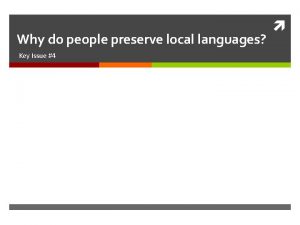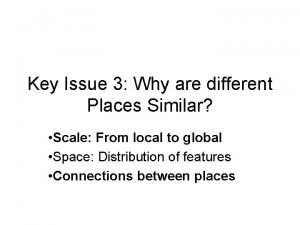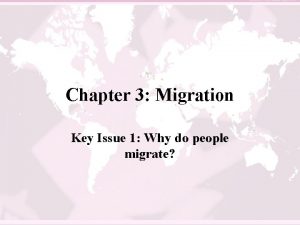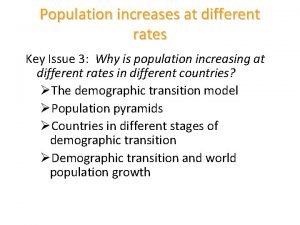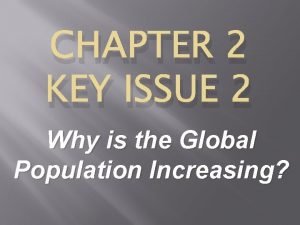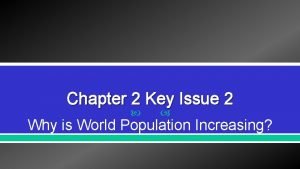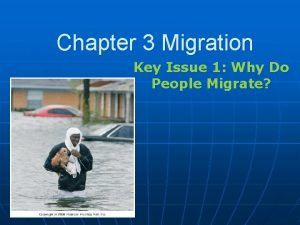CHAPTER 2 KEY ISSUE 3 Why Do Some





















- Slides: 21

CHAPTER 2 KEY ISSUE 3 Why Do Some Places Face Health Challenges?

Big Question • What challenges do women, mothers, the young, and the elderly face throughout the stages of the demographic transition model? How are the challenges different in developed and developing countries?

Key Terms • Maternal Mortality Rate • Infant mortality rates • Population Pyramids • Dependency Ratio • Graying • Epidemiology • Epidemiologic transition • Pandemics

Health and Gender • As countries enter later stages of the Demographic Transition Model, issues of health are of great concern to the booming populations that live there • Females face especially challenging health risks in these societies • Gender-based selection is huge problem in countries like China and India

Health and Gender • These countries have nearly 700, 000 female babies go “missing” per year…over 117 million since 1980 • The babies are either aborted, killed in infancy, or are moved and not accounted for

Health and Gender • The reason for this cultural preference for boys and government policies that limit the number of children a family can have • This has led to a higher ratio of boys to girls being born (sex ratio of 112: 100 as opposed to the norm of 105: 100)

Health and Gender • Mothers are at risk to in developing countries • Maternal Mortality Rate is described as the annual number of female deaths per 100, 000 live births from any cause related to or aggravated by pregnancy or its management • This rate is higher in in Asia and Africa… 100 deaths per 100, 000 births compared to 10 out of 100, 000 in North America and Europe (28 in U. S. )

Health and Gender • These same countries also have high infant mortality rates which measures the annual number of deaths of infants under 1 year of age (4 deaths per 1, 000 births in Europe and 64/1, 000 in Sub-Saharan Africa) • Advanced medical facilities and highly-trained personnel significantly limit the number of deaths to mothers and infants

Health and Aging • The percentage of people in different age groups varies as countries go through different stages of the DTM • Those in stage 2 have higher numbers of young people and those in stage 4 have higher numbers of the old

Health and Aging • Population Pyramids are bar graphs that display the percentage of a place’s population for each age and gender • The pyramid is broken down into 5 -year age groups, starting with 0 -4 with males on the left and females on the right • With a higher percentage of young or old, a country will have a higher dependency ratio

Health and Aging • This ratio is determined by the number of people under 15 or older than 65 compared to the number in their productive years who can support those who can’t • This number is higher in developing countries than in developed (47% in Europe compared to 85% in Sub-Saharan Africa)

Health and Aging • Some countries differ on who is dependent, old or young (Africa 14: 1 young to elderly ratio and the opposite in Japan with 3: 1 elderly to young) • Whether it’s a high number of children in a country or the “graying” of a population with a high number of elderly, it puts a significant strain on governments and those from ages 16 -65 to provide for the “dependents”

Medical Services • Health care varies widely around the world • Developed countries use part of their wealth to protect people who are unable to work • Public assistance is available to the poor, elderly, sick, disabled, young, and old

Medical Services • The amount spent on health care is much higher person in developed countries ($1, 000 to $5, 000 person) than in developing (less than $100 person) • Governments in those regions vary as well (15% of GDP in developed spent on healthcare compared to less than 5% in developing) • This level of spending is seen in the medical facilities and number of trained physicians in these countries (50 hospital beds and 30 physicians per 10, 000 people in Europe and 20 beds and 5 physicians per 10, 000 in Sub-Saharan Africa)

Medical Services • Most developed countries (with the exception of the U. S. ) provide health care at little or no cost to citizens but this is becoming increasingly difficult to maintain as their populations continue to age and need more health care • In developing countries, the challenge of keeping people healthy isn’t just financial but is also becoming more environmental

The Epidemiologic Transition • Epidemiology is the branch of medical science concerned with the incidence, distribution, and control of diseases • The epidemiologic transition focuses on distinctive health threats at each stage of the demographic transition model • Epidemiologists rely heavily on geographic concepts such as scale, space, and connection to control and prevent diseases

The Epidemiologic Transition • Stage 1 - Pestilence and Famine – “Natural checks” on human population came in the form of infectious or parasitic diseases. The deadliest example of this was the Bubonic Plague in the 14 th century that killed 25% of the world’s population

The Epidemiologic Transition • Stage 2 - Receding Pandemics – This stage sees the reduction of widespread pandemics or diseases that spread over a wide geographic region. Improved sanitation, nutrition, and medical services during the Industrial Revolution reduced the spread of deadly diseases such as Cholera. Countries in Stage 2 still deal with these problems (ex. Haiti) but are getting better at dealing with them

The Epidemiologic Transition • Stage 3 – Degenerative Diseases – This stage sees a decrease in infectious diseases and an increase in chronic disorders associated with aging. Heart disease and cancer are the most common and deadliest of these chronic disorders and we see the highest rates in developed countries

The Epidemiologic Transition • Stage 4 – Delayed Degenerative Diseases – This stage sees heart disease deaths and cancers killing less people through bypass surgeries and radiation therapies. Reductions in use of tobacco and alcohol also reduce the number of deaths. However, the big problem in this stage becomes sedentary lifestyles and overconsumption of non-nutritious foods leading to obesity

Big Question • What challenges do women, mothers, the young, and the elderly face throughout the stages of the demographic transition model? How are the challenges different in developed and developing countries? & Key Terms • Maternal Mortality Rate • Infant mortality rates • Population Pyramids • Dependency Ratio • Graying • Epidemiology • Epidemiologic transition • Pandemics
 Key issue 3 why do some places face health challenges
Key issue 3 why do some places face health challenges Key issue 4 why are some human actions not sustainable
Key issue 4 why are some human actions not sustainable Key issue 4 why are some actions not sustainable
Key issue 4 why are some actions not sustainable Hey bye bye
Hey bye bye Key issue 2 why are situation and site factors important
Key issue 2 why are situation and site factors important Key issue 1 why do services cluster downtown
Key issue 1 why do services cluster downtown Key issue 1 why are downtowns distinctive
Key issue 1 why are downtowns distinctive Chapter 9 key issue 4
Chapter 9 key issue 4 Key issue 3 why do individual languages vary among places
Key issue 3 why do individual languages vary among places Languages
Languages Dubai 1985
Dubai 1985 Why are different places similar?
Why are different places similar? How and why are places similar
How and why are places similar Key issue 3: why do people migrate?
Key issue 3: why do people migrate? Key issue 4 why do migrants face obstacles
Key issue 4 why do migrants face obstacles Key issue 4: why do migrants face obstacles?
Key issue 4: why do migrants face obstacles? Key issue 3 why does population growth vary among regions
Key issue 3 why does population growth vary among regions Chapter 13 key issue 1
Chapter 13 key issue 1 Chapter 12 key issue 1
Chapter 12 key issue 1 Chapter 12 key issue 4
Chapter 12 key issue 4 Chapter 11 key issue 4
Chapter 11 key issue 4 Language
Language









